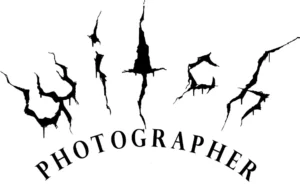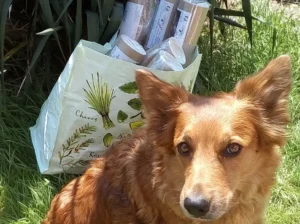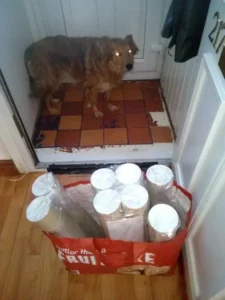Signed art giclée print in a tube with data sheets
On markets and in shops, I mostly sell mounted prints, though I carry a small selection of rolled prints in tubes too. I guess this is because it looks so finished, even though you’ve still got to get to the framers to put a frame around it and glaze.
I started carrying tubed prints for motorcyclists and Americans. To fit in backpacks and suitcases.
I sell rolled prints for about half price. It’s the materials: mount board, backing board, cellophane; the time it takes to cut mounts and carrying the suckers. It takes up room, they can get damaged, by children hitting them with sticks, by me, myself, I, dropping them, dropping things on them, Yannon scratching them chasing cats… So mounted prints are more expensive for all these reasons.
Rolled prints are also expensive to produce. The time it takes to photograph, edit, design, research… Granted, this is all good fun, but I’ve got to eat, so I can make more. As well as the pigment ink, which is unbelievably really, really expensive and the art paper, which is also expensive. And…
I’ve got to scrap many prints as waste. Bits of fluff, dog hair, printer errors, stumbling while moving a print from one room to another, Yannon shaking off from a muddy walk, all sorts of crappy, stupid things can happen to make a long, large print worthless.
Posting big, huge mounted prints is really tricky
I’ve got to wrap in bubble wrap, encase in strong cardboard – bigger sheets – which all takes a lot of time (and it’s just not fun) and hope Postie Pat doesn’t fold the damned thing to fit in his van. And of course, it’s quite expensive in stamps and insurance. Basically, all that extra card, work, costs and risk just makes it a dumb option.
Yes, I’ve done it a few times when I was first starting up and hated it. The extra work, the worry it would arrive damaged…
Take a rolled print to your framers
You’re not saving much by having a rolled print, nor losing much. The difference my rolled prints and my mounted prints (half/double) should be the amount the framer charges for the mount.
More choice
Your framer will have a massive range of mounts: colours, textures, thicknesses. As well as types, cheap or archival. You could also get double mounts, patterned corners, or cut outs. Your framer will help you decide. Or just tell him to use the cheapest!
Tips for dealing with a rolled print
Leave it alone! I make sure there are no greasy fingerprints, that the prints don’t have any creases or pyramid dinks. They’re rolled in perfect nick… Till you get it and give it to your kids.
So, leave it in the tube. Don’t be tempted to take it out to make sure it’s the one you ordered, or to look, see, admire. Don’t be tempted. Leave it till you take it to your final destination – the framers.
OK, so you just can’t resit it. Take it out of the tube carefully, obviously. You’re handing an expensive work of magical art here. Before you pull off the tape stopping it from unravelling, ensure there’s plenty of flat surface around, a table is best, if you’re on the floor, you really should have vacuumed.
Hold one end on the flat surface, better if someone else holds it. Yes, it’s best done with two people. Essential if it’s a really long one. Hold it down with a finger on the white edges. You did wash your greasy hands first, didn’t you? Just make sure you don’t touch the inked part of the picture.
Let it unravel itself mostly, don’t force it, and move it across the table. Use more fingers on the other white edge.
Of course, you can use nice paper weights so long as they’re smooth and clean. At your Framers, this is how you should leave it for as few days. Flat, with paper weights at each corner and something, like a dust sheet over the top. The object is to leave the paper to relax, taking out the curl from the roll, mostly.
To put it back in the tube, just roll it up, tightly, fairly tightly. Nearly tightly enough to fit back into the cardboard tube. Just insert your fingers in the rolled print and twist so you tighten it enough to fit into the tube, easily. Remember that bit of sticky tape to stop it unravelling.
Be careful to roll symmetrically, that is with equal pressure. You don’t want to roll it in an oval, a perfect circle is the desired section.
Oops! You dinked it
It’s not all over. Just ask your framer to dry mount it.
Now dry mounting comes in various flavours. The real way is by inserting a waxy sheet, like tracing paper between the picture and the backing board. It is actually wax. Then, squishing it under a big press that’s heated up to melt the wax. Shifting along to cover the whole print. This is the best way, but is more expensive, since not many framers will have such a big beast as a heated mounting press. The beauty is that you can reverse the process, heating it up and unpeeling the print. Skilled framers can do dry mounting with the wax sheet and an ordinary domestic iron. So I heard : )
Then there’s glue. Lots of potions and methods too many to mention.
All these methods can minimise dinks, those triangular paper folds that are the bane of my life. Personally, I scrap any prints with them.
If the shit hits the fan
And it’s gone all over your print, your little baby dropped an ice cream on it… These are pigment inks, I guess they could be washed. I’ve never tried it myself though.
Send it back. With a letter telling me in tear splattered detail what went wrong and I’ll replace it.
It’s our returns policy
If you don’t like it, for whatever reason, send it back for a refund of cost: picture and postage. Though you pay the postage back to return it to me.


